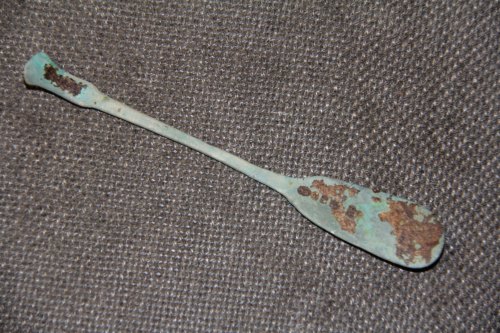
Image use policy
Our images can be used under a CC BY attribution licence (unless stated otherwise).
HANDLE
Unique ID: MAS-D100134
Object type certainty: Certain
Workflow
status: Published ![]()
The stem of a silver fork or spoon with a hallmark pattern.
The set of four hallmarks located together on the piece of cutlery indicates it was made later than 1781, when this practice was first introduced. Based on this image, this type of spoon/fork is possibly a Fiddle pattern - this refers to the shape of the handle - and is a type introduced in the 1780s and still in production today. The Fiddle pattern means that there are shoulders on the stem near the bowl, which is seen on this example. The lower end of the stem juts out around 90 degrees but this example may have been worn down in the marine environment. Dominant throughout the nineteenth century, Fiddle pattern is the most commonly found pattern from the 1800s. Originating in France, it first occurred in England from the 1760s without the shoulders on the stem near the bowl. The most common Fiddle pattern variants are Fiddle & Thread and Fiddle, Thread & Shell. The production of plain Fiddle pattern ceased around the time of World War One (https://www.antiquesilverspoons.co.uk/spoon-info accessed January 2018).
Notes:
This item was found with one stoneware salt glazed jar (MAS-D100132), two clear glass fruit bottles, one ornate green glass wine bottle, one black glass bottle, one tall wine bottle brown glass hexagonal at base (MAS-D100133) and three ceramic bottles (MAS-D100156).
Class:
FOOD PREPARATION AND CONSUMPTION
Sub class: CUTLERY
Subsequent actions
Current location of find: With finder
Subsequent action after recording: Submitted as wreck to the Receiver of Wreck
Wreck details
Droit number: 316/17
Chronology
Broad period: POST MEDIEVAL
Period from: POST MEDIEVAL
Period to: MODERN
Dimensions and weight
Quantity: 1
Discovery dates
Date(s) of discovery: Wednesday 18th October 2017
Personal details
Found by: This information is restricted for your login.
Recorded by: L R
Identified by: L R
Secondary identifier: V L
Other reference numbers
Droit ID: 316/17
Materials and construction
Spatial metadata
References cited
No references cited so far.
Similar objects

Find number: MAS-D100132
Object type: INK BOTTLE
Broadperiod: NINETEENTH CENTURY
One stoneware ink bottle.
Ink bottles or inkwells were made of various materials including glass, various metals, various stones, various woo…
Workflow: Published![]()

Find number: MAS-D100156
Object type: BOTTLE
Broadperiod: NINETEENTH CENTURY
Three salt glazed stoneware bottles. This form of bottle was a type used to carry seltzer water and gin.
Seltzer water was exported by vario…
Workflow: Published![]()

Find number: MAS-D100133
Object type: BOTTLES
Broadperiod: POST MEDIEVAL
Two clear glass fruit bottles, one ornate green glass wine bottle, one tall brown wine bottle with glass hexagonal base (94 stamped on base) a…
Workflow: Published![]()


